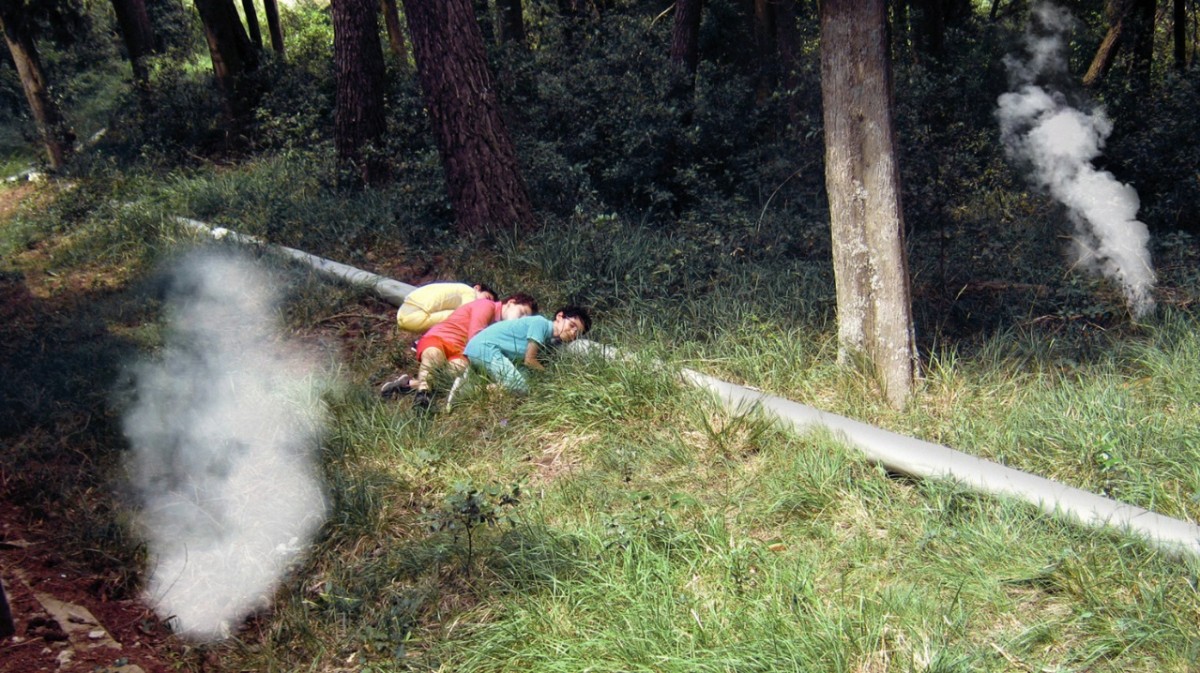


Mikhail Karikis, 'Children of Unquiet', 2013-14, video still 01. Image courtesy of the artist
The Daiwa Anglo-Japanese Foundation presents the work of the artists shortlisted for this year’s Daiwa Art Prize; Oliver Beer, Julie Brook and Mikhail Karikis. The winner was announced last night: Oliver Beer with Reanimation - Snow White, 2014. Beer has won a solo exhibition at the Aoyama-Meguro gallery in Tokyo, a participation fee and most importantly, exposure to Japan and its fascinating, complex and intricate culture. There are many art prizes in London, but the Daiwa is quite unique insofar as it sets a dialogue between countries. This exhibition offers the chance to think more carefully about what art prizes should do and the way they might relate with the culture, the politics, the aesthetics or the commercial aspects of a country; in this case Japan. The foundation’s mission is to foster anglo-japanese relations but don’t expect the artworks to be directly related to Japan here. This year’s prize takes us to the Namibian desert, inside an Italian power station and to the making of the American cartoon; but the works can relate to Japan in subtle ways.
Oliver Beer’s video occupies one of the main rooms facing the park, probably the living room of the original house. Sitting on the sofa, the winning work Reanimation - Snow White, 2014, is placed in front of us, we recognise the Disneyian character, yet something strange happened to her. The video is actually an assemblage of stills from Walt Disney’s movie (the first animation movie from 1937) with an uncanny feeling to it. Beer asked children to trace over the original Disney film-still, colouring as they wanted, reinterpreting the historical drawings. Beer collated these back to a 16mm film to create a new film, giving ownership to children of this classical children’s movie. A ‘Reanimation’ as the title says, but also a strong reference to collective imagination. It can also be an interesting way to think about animation in Japanese popular culture with manga, comics and anime.
In the next-door room, Julie Brook’s short films and drawings, dominated by variations of red, create a chromatic contraposition to the green of Regent’s Park. Brook’s video and drawings are a response to her experience in exploring the remote and uninhabited Namibian desert. Placing the two media in close dialogue with each other, the videos seem to respond to the drawings and vice-versa, showing how one can be a figure for thinking about the other. The persistent red colour, the desert in the videos and the drawings, recall the antique painted walls of Pompeii, that same colour that fascinated Mark Rothko and inspired some of his abstract canvases, while also being the colour the Japanese assign to the sun as figured in their flag.
The industrial ruins in the background of Mikhail Karikis’ Children of Unquiet, 2013-14, are taken over by children; once a power station the site seems to be their realm now. The video was shot in the Valle del Diavolo (devil’s valley) in the heart of Tuscany, where the world’s first geothermal power plant was build. In 1321 Dante wrote his Divine Comedy in Florence, and the Tuscan hills inspired his representations of hell, Inferno. Playing with the charged cultural connotations of the valley, Karikis depicts the ‘infernal’ power station, with its technical elements; its subterranean rumbles and compositional elements in dialogue with the natural setting. The children seem to be familiar with this futuristic environment and its geothermic noises; they play in its surroundings, imitate its sounds and read philosophical texts (I can recognise Michael Hardt and Toni Negri’s writings), discuss love; topics they cannot actually have knowledge of. The unsettling juxtaposition between the children, their ‘inappropriate’ readings and the infernal power station makes us wonder about their parents, who could be reading these texts and would have been working in the station.
Recreating a futuristic landscape, which remotely recalls the movie Stalker (1979) by Andrei Tarkovsky; Children of Unquiet demands to think about future generations and energy supplies, to consider more conscientiously the relation between natural and industrial surroundings, production needs and human values. It is another way to question the contradictions that capitalism generates and the possibilities of imagining a different future. For those who have been to the Venice Biennale this year, they can recognise a line of enquiry; for others it can point to the urgency to rethink industrial regeneration, the need to prevent catastrophes and our hopes to find a balance between the two. The catastrophic Fukushima nuclear accident in 2011 was not that long ago and I am thinking that perhaps a prize by an Anglo-Japanese foundation could engage with these issues mentioned above. How much should an art prize relate to the country that will host a solo exhibition of a British artist? And which aspects should the prize relate to? Political, environmental, cultural or commercial?
Oliver Beer will be appearing in Making It, a Contemporary Art Society managed exhibition at Sevenoaks School between 5-25 September 2015.
Daiwa Foundation Japan House, 13/14 Cornwall Terrace (Outer Circle), London NW1 4QP. Exhibition continues until 15 July 2015. Open Monday – Friday 09.30–17.00. www.dajf.org.uk